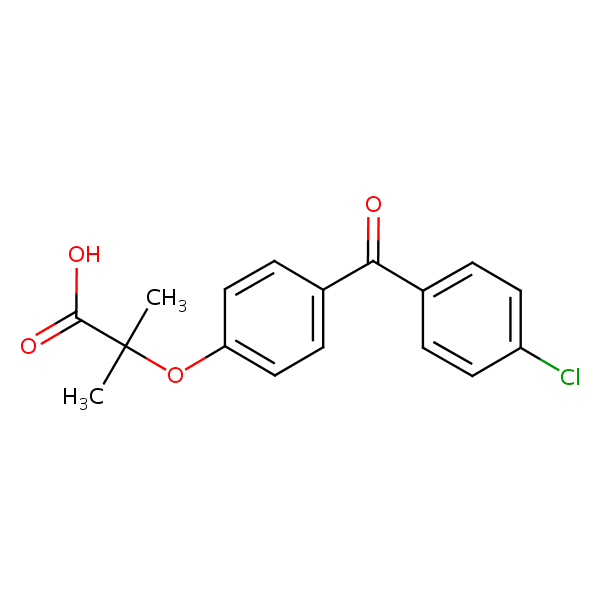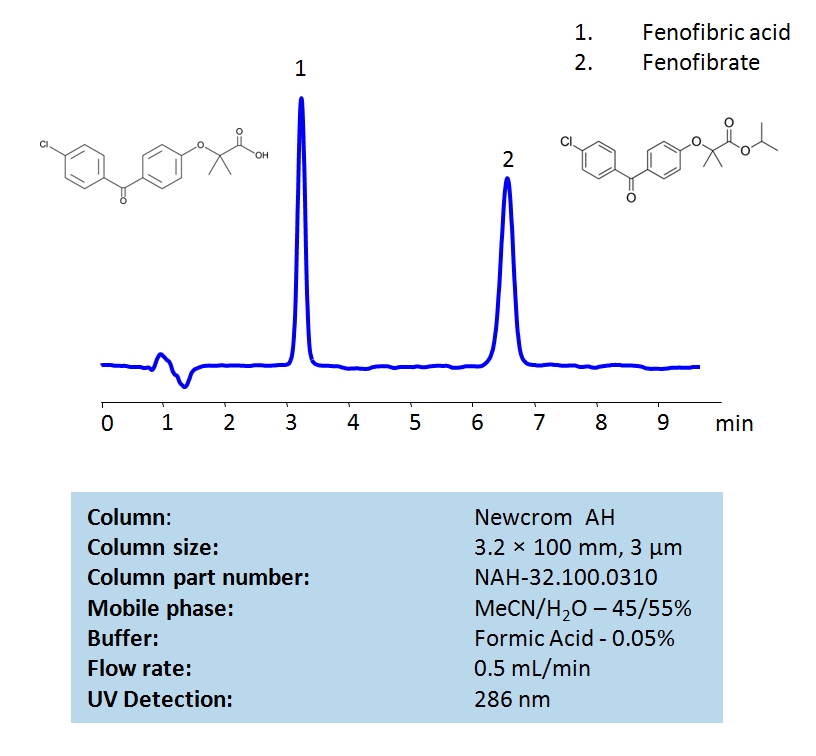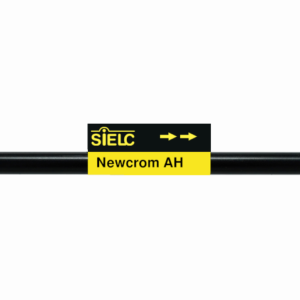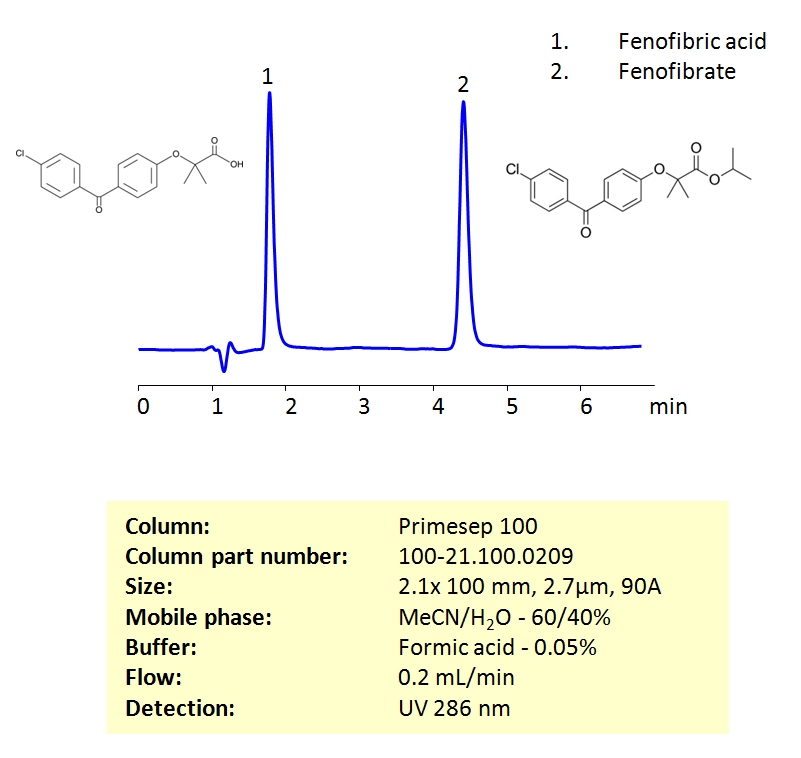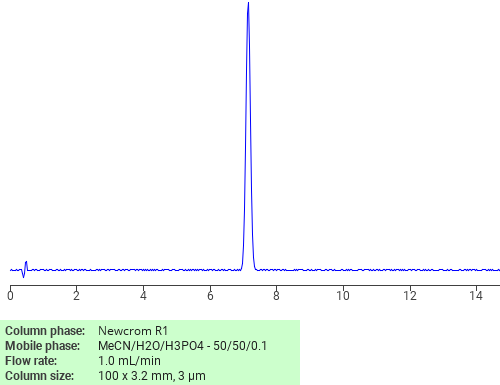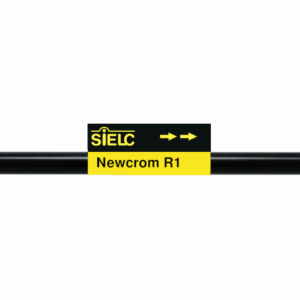| CAS Number | 42017-89-0 |
|---|---|
| Molecular Formula | C17H15ClO4 |
| Molecular Weight | 318.750 |
| InChI Key | MQOBSOSZFYZQOK-UHFFFAOYSA-N |
| LogP | 3.80 |
| Synonyms |
|
Applications:
HPLC Separation of Fenofibric Acid and Fenofibrate on Newcrom AH Column
September 1, 2021
HPLC Method for Fenofibric acid, Fenofibrate on Newcrom AH by SIELC Technologies
High Performance Liquid Chromatography (HPLC) Method for Analysis of Fenofibric acid, Fenofibrate.
Fenofibric acid is used to treat high levels of cholesterol and triglyceride in blood, which can help prevent pancreatitis. It works through activating peroxisome proliferator-activated receptor alpha. This leads to increased activity lipoprotein lipase and decreased production of proprotein.
Fenofibrate is used to treat high levels of cholesterol and triglyceride in blood, which can help prevent pancreatitis. It works when it is converted into Fenofibric acid, listed above.
Fenofibric acid, Fenofibrate can be retained and analyzed using the Newcrom AH stationary phase column. The analysis utilizes an isocratic method with a simple mobile phase consisting of water and acetonitrile (MeCN) with a formic acid buffer. Detection is performed using UV.
| Column | Newcrom AH, 3.2 x 100 mm, 3 µm, 100 A, dual ended |
| Mobile Phase | MeCN – 45% |
| Buffer | Formic Acid – 0.05% |
| Flow Rate | 0.5 ml/min |
| Detection | UV, 286 nm |
| Class of Compounds |
Drug, Acid, Hydrophilic, Ionizable, Supplements |
| Analyzing Compounds | Fenofibric acid, Fenofibrate |
Application Column
Newcrom AH
Column Diameter: 3.2 mm
Column Length: 100 mm
Particle Size: 3 µm
Pore Size: 100 A
Column options: dual ended
Fenofibric acid

HPLC Separation of Fenofibric Acid and Fenofibrate on Primesep 100 Column
September 1, 2021
HPLC Method for Fenofibric acid, Fenofibrate on Primesep 100 by SIELC Technologies
High Performance Liquid Chromatography (HPLC) Method for Analysis of Fenofibric acid, Fenofibrate.
Fenofibric acid is used to treat high levels of cholesterol and triglyceride in blood, which can help prevent pancreatitis. It works through activating peroxisome proliferator-activated receptor alpha. This leads to increased activity lipoprotein lipase and decreased production of proprotein.
Fenofibrate is used to treat high levels of cholesterol and triglyceride in blood, which can help prevent pancreatitis. It works when it is converted into Fenofibric acid, listed above.
Fenofibric acid, Fenofibrate can be retained and analyzed using the Primesep 100 stationary phase column. The analysis utilizes an isocratic method with a simple mobile phase consisting of water and acetonitrile (MeCN) with a formic acid buffer. Detection is performed using UV.
| Column | Solid-Core Primesep 100, 2.1 x 100 mm, 2.7 µm, 90 A, dual ended |
| Mobile Phase | MeCN – 60% |
| Buffer | Formic Acid – 0.05% |
| Flow Rate | 0.2 ml/min |
| Detection | UV, 286 nm |
| Class of Compounds |
Drug, Acid, Hydrophilic, Ionizable, Supplements |
| Analyzing Compounds | Fenofibric acid, Fenofibrate |
Application Column
Solid-Core Primesep 100
Column Diameter: 2.1 mm
Column Length: 100 mm
Particle Size: 2.7 µm
Pore Size: 90 A
Attribute: none
Column options: dual ended
Fenofibric acid

Separation of Fenofibric acid on Newcrom R1 HPLC column
May 16, 2018
Fenofibric acid can be analyzed by this reverse phase (RP) HPLC method with simple conditions. The mobile phase contains an acetonitrile (MeCN), water, and phosphoric acid. For Mass-Spec (MS) compatible applications the phosphoric acid needs to be replaced with formic acid. Smaller 3 µm particles columns available for fast UPLC applications. This liquid chromatography method is scalable and can be used for isolation impurities in preparative separation. It also suitable for pharmacokinetics.
Application Column
Newcrom R1
The Newcrom columns are a family of reverse-phase-based columns. Newcrom A, AH, B, and BH are all mixed-mode columns with either positive or negative ion-pairing groups attached to either short (25 Å) or long (100 Å) ligand chains. Newcrom R1 is a special reverse-phase column with low silanol activity.
Select options